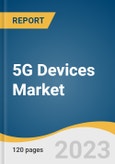5G Devices Market Growth & Trends
The global 5G devices market size is expected to reach USD 1.26 trillion by 2030, growing at a CAGR of 36.4% from 2025 to 2030. Beyond consumers, the enterprise and industrial sectors are increasingly adopting 5G devices to improve efficiency and productivity. Businesses are integrating 5G capabilities into their operations, enabling tasks such as remote maintenance, augmented reality-based training, and autonomous robotics. These applications necessitate the use of 5G devices for seamless connectivity, which is instrumental in reducing operational costs and enhancing competitiveness.Smart cities, which leverage advanced technologies to optimize urban living, are embracing 5G as a core component. From smart traffic management to efficient waste collection, these initiatives depend on 5G devices to function cohesively. As the development of smart cities continues, there is a growing demand for 5G-compatible devices that can support the data-intensive, interconnected systems crucial to these urban projects.
Government initiatives and regulations are playing a key role in driving the adoption of 5G devices. Many governments recognize the significance of 5G technology in bolstering their economies and enhancing connectivity for their citizens. They are implementing policies and regulations that support the deployment of 5G infrastructure, making it more accessible to the general public and various industries. The wider access to the 5G network is driving the demand for 5G devices.
Supply chain disruptions from the pandemic pushed device manufacturers to innovate and improve production processes, allowing for more cost-effective and widespread deployment of 5G devices. As the pandemic forced the world to adapt to new ways of living and working, it inadvertently fueled market growth. It plays a role in the broader rollout of 5G networks and fostering technological advancements that promise to reshape industries and consumer experiences for years to come.
5G Devices Market Report Highlights
- In terms of form factor, the phones segment dominated the market in 2024. Telecommunications carriers worldwide have been actively promoting 5G adoption, often bundling with compelling phone upgrade offers, encouraging users to make the shift
- Based on spectrum, the sub-6 GHz-based segment dominated the market in 2024 with a revenue share of over 66.86%. Many telecom operators worldwide have focused on deploying sub-6 GHz 5G networks, making compatible devices more readily available to consumers. In addition, sub-6 GHz frequencies are generally less affected by signal blockages from obstacles like buildings and trees compared to higher frequency mmWave technology, ensuring a more reliable and consistent user experience
- Asia Pacific dominated the market in 2024 with a revenue share of more than 45.93%. Asia Pacific's status as a technology hub has driven innovation and a strong focus on research and development in 5G technology. This has led to a multitude of cutting-edge 5G devices, not only in the smartphone segment but also in areas such as IoT, automotive, and industrial applications
Why should you buy this report?
- Comprehensive Market Analysis: Gain detailed insights into the global market across major regions and segments.
- Competitive Landscape: Explore the market presence of key players worldwide.
- Future Trends: Discover the pivotal trends and drivers shaping the future of the global market.
- Actionable Recommendations: Utilize insights to uncover new revenue streams and guide strategic business decisions.
This report addresses:
- Market intelligence to enable effective decision-making
- Market estimates and forecasts from 2018 to 2030
- Growth opportunities and trend analyses
- Segment and regional revenue forecasts for market assessment
- Competition strategy and market share analysis
- Product innovation listing for you to stay ahead of the curve
- COVID-19's impact and how to sustain in these fast-evolving markets
This product will be delivered within 1-3 business days.
Table of Contents
Chapter 1 Methodology and Scope
Chapter 2 Executive Summary
Chapter 3 5G Devices Market Variables and Trends
Chapter 4 5G Devices Market: Form Factor Estimates & Trend Analysis
Chapter 5 5G Devices Market: Spectrum Estimates & Trend Analysis
Chapter 6 5G Devices Market: Regional Estimates & Trend Analysis
Chapter 7 5G Devices Market - Competitive Landscape
List of Tables
List of Figures
Companies Mentioned
- ZTE Corporation
- Xiaomi
- Samsung
- Sony Group Corporation
- D-Link
- Huawei
- Nokia Corporation
- Fibocom Wireless, Inc.
- Inseego Corp
- Askey Computer Corp.
- HTC Corporation
Methodology

LOADING...








